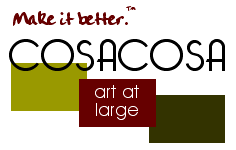



The rise of humanistic psychology in the mid-twentieth century further marginalized our perception of art and art-making. The work of Abraham Maslow and other theorists placed the creative experience in the exclusive domain of a “self-actualized” elite. According to Maslow, the rest of us – preoccupied as we are with finding food, shelter, safety, love and recognition – never are free to seek or receive aesthetic enlightenment. Still other intellectuals continue to exacerbate our cultural divisions with futile attempts to define creative worth or “high art.” Such models run counter to art’s original, inclusive nature – as a gathering, healing and empowering force for and within a shared community.
By recapturing this essential role for art in our society, we can rediscover, reaffirm and redefine our community and cultural identities. We can recognize our connectedness and the strength in our diversity. We can restore and revitalize our neighborhoods. We can enable every citizen to bring forth a creative voice that realizes and renews art’s ancient passage of positive change and growth. We can recover our Muse.
COSACOSA works with Philadelphia residents to create collaborative and interactive public art. During the past year, our Connection project explored themes common to all of our human experience, transcending the bounds of culture and community. Connection is site-specific to the connecting walkway between Philadelphia International Airport Terminals C and D. The 80' by 5' ceramic mural joins the two terminals both physically and metaphorically. The lower, outside corners of the piece contain outstretched human hands, avian in form, objects of flight. Issuing from the hands against a deep blue sky is a macrocosmic arc joining the full expanse of the exhibition space – filled with small, detailed sculptures by young COSACOSA artists.
COSACOSA brought together young people city-wide – pediatric hospital patients with neighborhood youth – to describe needs, ideas, hopes and desires that they believed were shared by people all over the world. Our young participants then created the over 1,200 miniature Connection sculptures based on their discussions.
The children were remarkably intuitive in defining how we are all connected. Their artwork provides a visual laundry list of needs virtually sourced from one of Maslow’s charts – family, friends, love, honor, refuge, food, clothing, and compensation all find representation. Sports, television, and cell phones recall our modern obsessions. Images of the environment, intercultural unity, and world peace attest to the major concerns of our youth. Connection participants also created hundreds of ceramic stars – colorfully painted on the outside, with secret wishes for themselves and for their world written on the side affixed to the finished installation.
At the airport, Connection reminds the travelling public of the ties that bind us together, no matter who we are, whence we come, or where we go. For the project’s young artists, the fullness of human experience now is bound inextricably to the rise and acknowledgment of their own shared community. Art makes the connection.
Interdisciplinary artist Kimberly Niemela is Founder and Director of COSACOSA. Her work in film and sound has been performed/exhibited in a variety of venues, including, in New York, Central Park and El Museo del Barrio and, in Philadelphia, the Painted Bride Art Center and Taller Puertorriqueño. Her public art designs have been widely acclaimed and featured in the international award series Designing the World's Best Children's Hospitals.